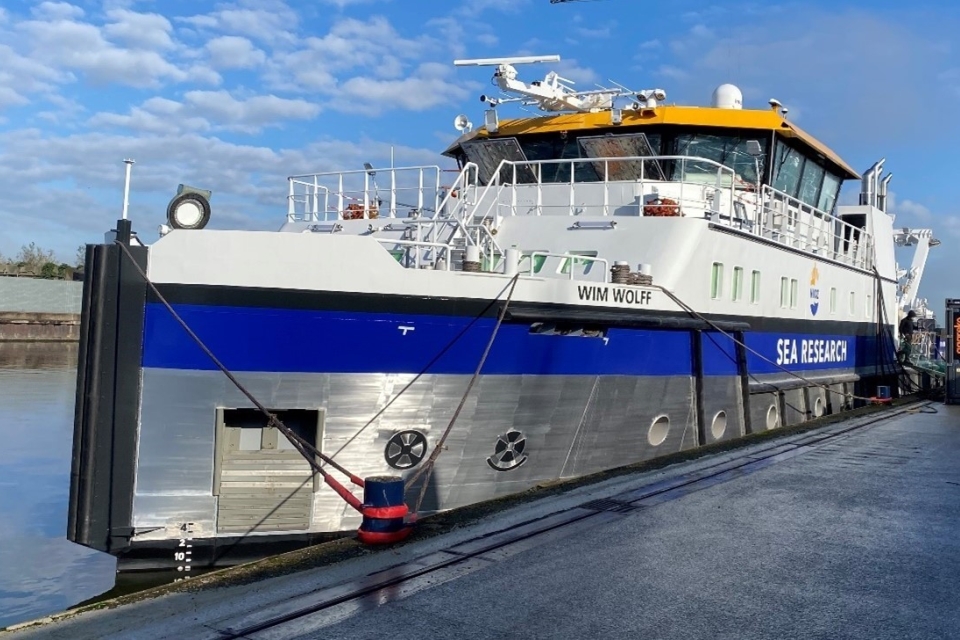Thursday, 15 February, the RV Wim Wolff will be christened in the harbour of the Royal Netherlands Institute for Sea Research (NIOZ) on Texel. This research vessel (RV) replaces the RV Navicula, which served for four decades in coastal research.
The new vessel is named after the godfather of ecological research in the Wadden Sea, who passed away in 2018.
‘With the Wim Wolff, we have a comfortable, innovative and, above all, a sustainable vessel, with which we can face the future of research in the North Sea coastal zone, the Southwest Delta and the Wadden Sea,’ says Aarnoud van de Burgt, the head of NIOZ‘s National Marine Facilities Department.
Also read: VIDEO: New NIOZ research vessel Wim Wolff launched
Monitoring the state of the Wadden Sea
This new research vessel has long been awaited by many field researchers, from NIOZ and beyond.
‘This ship is quite a bit bigger than the Navicula,’ says Wadden ecologist Allert Bijleveld of NIOZ. ‘That means we can bring not just four, but even six fully equipped dinghies on board. This allows us to carry out our annual sampling of all tidal flats, as part of the SIBES programme, in an even shorter and thus more precise period.’
SIBES is the large-scale monitoring program on the composition of the soil and benthic life. It forms the basis of knowledge about the state of the Wadden Sea and everything that lives in it. ‘SIBES is, by all means, a programme that benefits from scientific stamina and with the Wim Wolff we at least have the technical facilities to continue this important work for decades to come.’
Bijleveld also conducts research in the Wadden Sea using tiny WATLAS-transmitters on birds and antenna stations on the mudflats. ‘Until today, we had to build those antennas on large scaffolds that we constructed by hand. With the new, stronger ship, we can simply push the tubes for the antennas into the bottom, using the crane on the ship.’
For all Dutch coastal researchers
NIOZ researcher Tjisse van der Heide, who is also a professor of coastal ecology at the University of Groningen, is also looking forward to working on the new ship. ‘The Wim Wolff is completely up to date again; bigger and more stable than “the Nav”. That means we can work even better with, for example, a box-core. That is a heavy device with which we can take large bottom samples, working on the stern of the ship.’
Van der Heide also works within the larger project Wadden Mosaic, a Wadden Fund project in which NIOZ and RUG collaborate. ‘It is important to stress that this new research vessel is not just available to NIOZ researchers. It can be used for all coastal research, including that of fellow institutes.’
As sustainable as possible
‘The RV Wim Wolff was built according to the most modern insights and has also been made as sustainable as possible, both in construction and in use,’ states Aarnout van de Burgt. ‘The ship runs on vegetable fuel and has a large package of batteries aboard. It is also prepared for a future with even greener fuels, such as methanol. And last but not least, it is also a lot more comfortable and user-friendly, both for the crew as well as for the guests from the scientific field.’
The RV Wim Wollf is a so-called flatboat, which means it can run dry on the mud flats. Yet it is still capable of sailing up to 20 miles offshore. ‘That makes use along the entire Danish, German, Dutch and Belgian coast possible,’ Van de Burgt adds.
Also read: What makes the new research vessel Wim Wolff sustainable?
Christened by new generation
Because the christening of a ship is traditionally performed by a woman, and because namesake Wim Wolff had two sons, the christening will be performed by Wim’s five-year-old granddaughter Charly Wolff, assisted by Caroline Visser, board member of NWO, the Dutch Research Council. Youthful “christening lady” Charly also symbolises the future of the ship and the coastal research. RV Wim Wolff, like the RV Navicula, is expected to last four decades.
Also read: RV Anna Weber-van Bosse will be able to perform top-notch research
New national research fleet
The vessel is the second of three from the new research fleet for Dutch coastal, marine and ocean research and was built by Thecla Bodewes Shipyards in Harlingen. In 2022, the assistance vessel RV Adriaen Coenen was already commissioned.
In 2023, a shipyard in Spain started building the RV Anna Weber-van Bosse, the new vessel for research on the open seas and oceans. It will replace the RV Pelagia in late 2025. The Dutch research fleet is managed by the National Marine Facilities (NMF) department of NIOZ, part of NWO.
Picture: The final works are currently taking place at Thecla Bodewes Shipyards (photo by NIOZ).
Also read: NIOZ: It is too early for commercial deepsea mining








